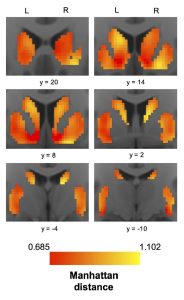
A portion of a figure from this publication
Featured Paper of the Month – March 2022
Published in Cerebral Cortex by Thomas Ross and Elliot Stein of the NIDA IRP Cognitive and Affective Neuroscience of Addiction Section.
Summary
The right and left hemispheres of the brain each play a dominant role in certain functions, such as inhibitory control (right) and language (left). Differences in the structure and connections of the right and left hemispheres (i.e., “lateralities”) help to facilitate these functional specialties. Yet, in several neurodevelopment and neuropsychiatric disorders – including addiction – these hemispheric lateralities appear to be abnormal. In this paper, NIDA scientists provide a normative description of laterality in the circuits that connect the frontal cortex to the striatum – a system centrally implicated in addiction. We found that in healthy adults (n=261), a handful of specific locations in the striatum display disproportionately different profiles of connections with the right frontal cortex versus the left frontal cortex. Moreover, at these so-called “laterality hotspots”, the magnitude of connectional laterality in a given individual was significantly associated with his/her performance on tasks that gauge lateralized functions (i.e., inhibitory control and language). Findings were replicated in an independent sample and survived several tests of robustness. Overall, our findings provide a normative template with which to evaluate potential abnormalities of corticostriatal laterality in addiction and other forms of psychopathology.
